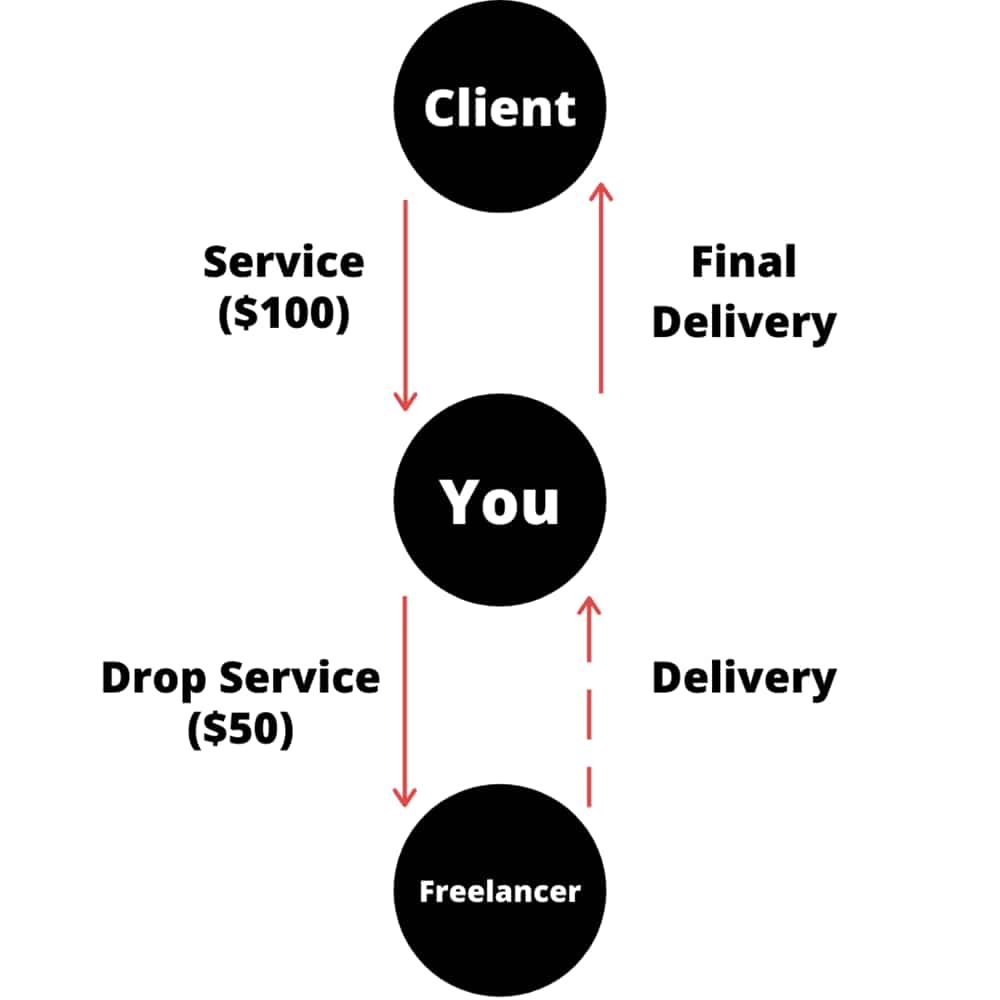What Is Drop Servicing? Definition, Examples, and More
What Is Drop Servicing?
Drop servicing is the practice of selling a service to a customer for a certain price (say $100). Then hiring someone else to provide the service for the client at a lower price ($50), and pocketing the difference without the client knowing you outsourced the project.
Drop servicing is also known as “service arbitrage.” You can arbitrage the price difference between what a client is willing to pay for the service and what someone is willing to get paid to perform the service.
Visual example of drop servicing a service from a client.
How Does Drop Servicing work?
Say you find a client who needs writing services for their website. They are willing to pay you $1,500 for the delivery of 10 articles over the next 10 weeks.
If you decide to drop service this job, first you’ll find a freelance writer who is willing to write the articles for less than the $1,500 you are getting paid (say $1,000). Then, you get the articles back from the writer and deliver them to the client.
You’ve paid out $1,000, gotten paid $1,500 and pocket $500 for your trouble.
Drop Servicing Examples
Creative Agencies
Creative agencies that work on behalf of brands to create content have been drop servicing for decades. The creative agency doesn’t usually produce the content they’ve sold through with their client - they outsource the job to someone else (usually a production company).
The key difference here, though, is that the client knows the agency is outsourcing the production of the asset. There’s transparency between the client, agency, and service provider.
Digital Products
There’s a decent chance that any digital product you’ve bought online was written by someone on Fiver for less than you paid for it. That’s how the “creator” makes their money - by arbitraging the price you are willing to pay for the product and the price they can hire a freelancer to create it.
Social Media Management
Many social media firms outsource content creation to freelancers and then deliver the content as their own to the client.
Other Drop Servicing Examples:
Graphic Design
Video Production
Audio Production
Podcast Creation
Copywriting
Website Design
Drop Servicing is Scalable
Drop servicing allows you to scale your business in a way that’s not possible if you do all the work yourself.
If you write all the blog posts, create all the content, design all the graphics, and write all the social media updates yourself, your income is limited to the number of hours you can work in a day.
But with drop servicing, you can get paid by the project and payout by the hour. There’s no limit to the number of projects you can take on, assuming you can outsource them effectively.
Drop servicing is scalable in a way your time is not.
Negatives of Drop Servicing
Quality control
The most obvious negative attribute of drop servicing is a lack of quality control. You don’t have full control over the quality of the digital service because you aren’t doing it yourself.
You may end up spending a lot of time fixing other people’s work if you outsource to the wrong provider. This eats away at your margin and your time.
To solve this, make sure you have several vetted, qualified freelancers who you trust. Put effort into building relationships with great freelancers so when a deadline looms, you can count on them to deliver.
Moral Ambiguity
There’s also a potential moral issue if your client doesn’t know you are drop servicing the service.
If they think you are handling the service on your own and you don’t tell them you’re outsourcing the job, that’s morally ambiguous.
It’s not playing the long game with your business.
If you do drop service, make sure you are upfront about your process. Let your client know that you have a team of qualified freelancers who you manage and that you take responsibility for all deliverables.
Drop Servicing Summary
The act of drop servicing has been around much longer than the word to describe it has. But now that there’s a word for it, I expect it to take off in popularity.
It’s scalable, profitable, and relatively easy to do.
Start now.

